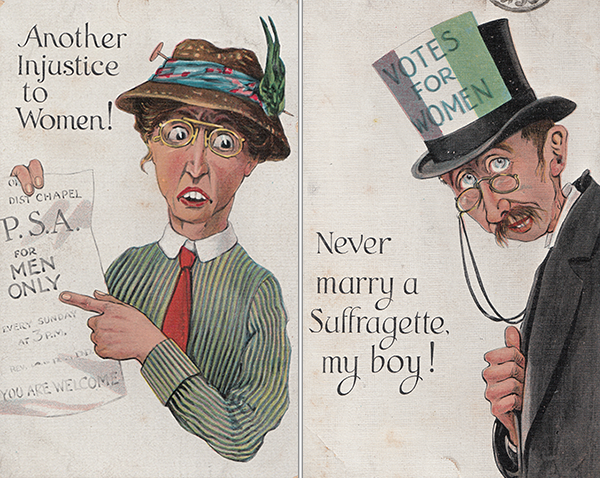Anti-suffragette postcards, c. 1913
Published in Artefacts, Issue 3 (May/June 2018), Volume 26
By Donna Gilligan
The use of the postcard as a medium of mass communication was embraced by the international women’s suffrage movement, which recognised it as a cheap and effective means of propaganda. Women’s suffrage was also a postcard theme used frequently by commercial publishers, who commonly produced designs that showed suffrage campaigners in an uncomplimentary light. Imagery mainly focused on the ‘suffragette’—the female campaigners involved in militant political activity, such as window-breaking and postbox attacks.
Two commercially produced postcards sent from Windgates in Wicklow to Stillorgan in Dublin in 1913 show some of the depictions of suffragettes and their supporters in circulation in Ireland during the height of the campaign. Produced by Valentine’s Co. Ltd, they are part of a specific series manufactured by the publishers which demonstrate anti-suffragette sentiment.

Above: Two of a series of anti-suffragette postcards by Valentine’s Co. Ltd, commercially produced in 1913.
One of the cards shows an apparently hen-pecked, submissive husband, imploring the male viewer to ‘Never marry a suffragette, my boy!’ Male suffrage supporters were often publicly ridiculed for their stance. Association with the campaign was seen as a feminine and emasculating pursuit, and Irish suffragists like Francis Sheehy Skeffington were regularly lampooned. The husband’s dress—pince-nez glasses, top hat and suit—identify his middle-class social standing. The campaign often faced criticism for its middle-class origins, and was seen to exclude a large section of the female population who didn’t have the same access to social, financial and educational opportunities. The ‘Votes for Women’ placard on his hat shows the colours of the Women’s Social and Political Union (WSPU), the English women’s suffrage organisation for whom the term ‘suffragette’ was originally coined as an insult. The Irish equivalent of the WSPU, the Irish Women’s Franchise League, used their own organisational colours of orange and green to distinguish themselves from the English campaign.
The second postcard displays one of the most common mocking depictions of the suffragette—the ugly, old-fashioned harridan or spinster. Much anti-suffragette imagery delighted in presenting the women involved as angry, violent, jealous older women, and often hinted that their frustration stemmed from their inability to obtain a husband. The woman in the postcard—outraged at the announcement of a men-only meeting—is dressed in clothes inspired by the Rational Dress movement. Rational Dress, a protest against female fashion that restricted a woman’s movement, introduced a change in clothing to a more practical and comfortable style to suit its use in physical activities by the New Woman. This clothing style was often considered masculine at the time owing to its incorporation of elements such as blazers, ties and blouses. This dress formed part of the negative visual stereotype of the suffragettes, with the international press mocking their choice of ‘manly’ clothing and using this style to show how such women were inherently unfeminine and unnatural.
Donna Gilligan is curator of the exhibition Print, Protest, and the Polls: the Irish women’s suffrage campaign and the power of print media, 1908–1918, which runs at the National Print Museum, Beggar’s Bush, until 30 September 2018.
















